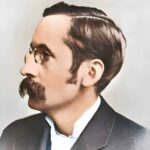
B.M. Bower: Pioneering Influence in Western Fiction Literature
Born: 15 November 1871
Died: 23 July 1940
Country: United States of America
Notable work: Chip of the Flying U
Bertha Muzzy Bower, widely known as B.M. Bower, was a prolific American author renowned for her contributions to the genre of Western novels. Born in 1871, she adopted the pen name B.M. Bower, under which she published many of her works that vividly depicted the life of cowboys and settlers in the American West. Her successful writing career began in the early 20th century, a time when the Western genre gained popularity among readers fascinated with tales of frontier life.
Bower’s novels stand out for their detailed portrayal of ranch life and the landscapes of the West, which she knew intimately. She was one of the first female authors to make a significant impact in a genre predominantly dominated by male writers. Her work not only entertained but also provided a nuanced perspective on the personal and societal challenges of the time.
Over her career, B.M. Bower wrote more than 60 novels along with numerous short stories. Her most famous work, Chip, of the Flying U, introduced readers to the well-loved character of Chip Bennett and was the first in a series that would establish her as a significant figure in Western literature. Through her engaging storytelling and authentic characters, she earned a respected place among the authors who shaped the American literary landscape.
1. Life and Literary Career
B.M. Bower, born Bertha Muzzy, was a prolific American author who specialized in Western fiction. Her works encapsulate the essence of the American Old West, painting vivid pictures of ranch life and rugged landscapes. Her life mirrored the adventurous spirit of her novels, marked by personal turmoil and professional triumphs.
1.1. Early Years and Personal Life
Bower was born on November 15, 1871, in Eden, Minnesota. She was the daughter of Washington Muzzy and Eunice Miner Muzzy and showed an early interest in literature. Teaching was her first profession, which she pursued before venturing into full-time writing.
B. M. Bower’s life was as eventful as her novels. On December 21, 1890, she eloped with Clayton J. Bower, marking the beginning of an unhappy marriage. The couple, after staying with Bower’s family, moved to Great Falls and later to Big Sandy, Montana. Bower’s experiences in Big Sandy provided her with a deep understanding of cowboy life, essential for her Western novels. She had three children with Clayton: Bertha Grace, Harold Clayton, and Roy Noel.
The family’s move to an isolated cabin, which Bower nicknamed “Bleak Cabin,” became a turning point. Here, Bower formed a partnership with a boarder, Bill Sinclair, who was nine years younger. Sinclair helped Bower refine her writing and understand cowboy life, while she tutored him and lent him books. During this period, Bower’s marriage further deteriorated, especially after the success of her novel Chip of the Flying U, leading to her husband’s demeaning attitude and eventual violent behavior.
With Sinclair’s support and earnings from her novel, Bower moved to Tacoma, Washington. Her divorce was finalized in 1905, with Clayton taking custody of two children and Bower keeping Roy. Despite these challenges, she continued to advance her career, signing a contract with Popular Magazine.
Bower and Sinclair married in 1905 and settled in Great Falls, focusing on their writing careers. They had a daughter, Della Frances Sinclair, but faced hardship when they lost their horse herd. This loss led them to leave Montana for Santa Cruz, California. Bower and Sinclair continued their successful writing careers but eventually separated in 1911. Bower then moved to San Jose and changed publishers.
In 1920, Bower moved to Hollywood and married Robert “Bud” Cowan, a cowboy she had met in Big Sandy. Together, they operated a silver mine in Nevada until the Great Depression. They then relocated to Depoe Bay, Oregon, where they stayed until Cowan’s death in 1939. Bower did not remarry after Cowan’s death.
1.2. Writing Success and Publications
Bower’s literary career began at the dawn of the 20th century when the Western genre was gaining popularity. Her first novel, The Range Dwellers, was published in 1906, followed by over 30 novels, including notable titles such as The Happy Family (1910), The Flying U’s Last Stand (1915), and The Ranch at the Wolverine (1914). Her stories were serialized in popular magazines, further spreading her fame and establishing her as a key figure in Western fiction. Bower’s body of work also includes numerous short stories and serials like The Gringos (1913).
2. B.M. Bower Influence and Legacy
Throughout her career, Bower influenced the perception of Western geography and history with her descriptive writing. Her novels shaped the cultural narrative of the American frontier, making an indelible impact on the genre. Her contributions to literature extend to the Western History Collections at the University of Oklahoma Libraries, where her papers and manuscripts are preserved, evidencing her longstanding influence.
2.1. Works in Media and Adaptations
Bower’s novels proved popular for adaptation in Hollywood. Films like Chip of the Flying U (1914) and The Phantom Herd (1916) brought Bower’s characters and settings to life. The Flying U Ranch and the Happy Family series were particularly beloved, sparking multiple films and screenplays that contributed to Bower’s popularity and the Western genre’s growth in early cinema.
2.2. Archives and Posthumous Recognition
Ebook versions of Bower’s works are accessible through platforms like Project Gutenberg, ensuring her stories reach new generations. Her legacy is also preserved at the Western History Collections of the University of Oklahoma Libraries, confirming her status as a significant author beyond her lifetime. Through these archives, Bower’s contributions to literature and the Western genre continue to be recognized and celebrated.




